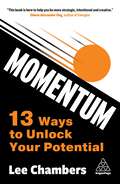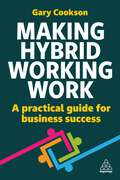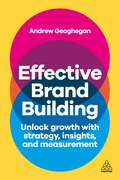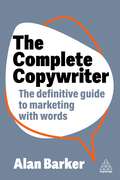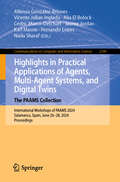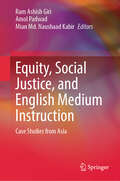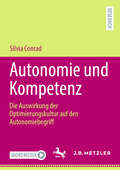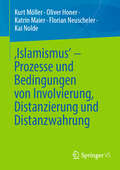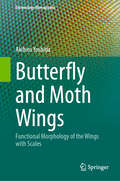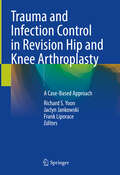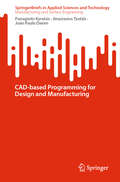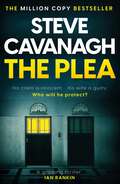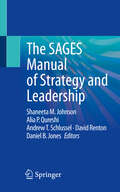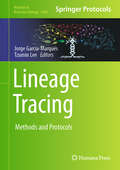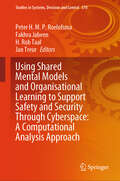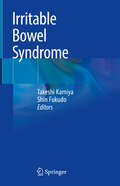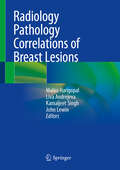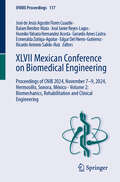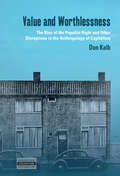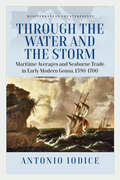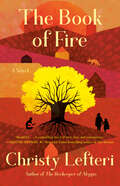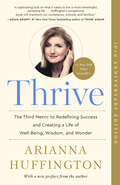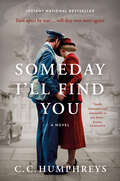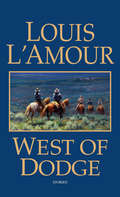- Table View
- List View
Momentum: 13 Ways to Unlock Your Potential
by Lee ChambersFor many of us, our lives have become over-complicated, defined by burnout and fatigue. This affects everything we do, from our home life to our work. We stop moving forward and we lose direction.But there is an alternative: build your Momentum and rediscover the joys of fulfilling your potential. Leading psychologist and wellbeing expert, Lee Chambers found success by prioritizing wellbeing and embracing uncertainty. In this book, he shares his thirteen essential tools to help you unlock your potential. From having a flexible vision and identifying how failure can move us forward, through to loving life's squiggles and working with empathy, you'll learn how to redefine success, wake up feeling excited about what you do and find your purpose.Momentum will keep you moving and is guaranteed to help you enjoy the ride.
Making Hybrid Working Work: A Practical Guide for Business Success
by Gary CooksonHybrid work is here to stay but we haven't got it right yet. To be truly effective, hybrid working must form part of the overall business strategy and work, organizational structures and teams must be designed with hybrid in mind. Making Hybrid Working Work is a practical book for senior business practitioners and people professionals wanting to ensure that hybrid working works for their people and their business. With guidance on leading, managing and developing hybrid workers, this book will help you embed hybrid working into your organization design. This book explores what hybrid means for your office real estate, how to choose the right technology for hybrid working and how to ensure you're only investing in automating the correct things. It discusses how to use data to take an evidence-based approach to solving problems in a hybrid organization and how you can support learning for hybrid workers, build a learning culture and prioritize performance, not location. With coverage of managing the hybrid employee experience with a focus on company culture, this book also includes the latest research, interviews with those who have experienced the benefits and challenges of this way of working and real-world examples from companies including Centrica, what3words and EMIS Health. Discover how to be deliberate about hybrid ways of working and not leave success to chance with this essential guide.
Effective Brand Building: Unlock Growth with Strategy, Insights, and Measurement
by Andrew GeogheganInvestment and focus on brand building skills has diminished across the marketing industry in recent years. But without the knowledge and understanding of how to build strong brands, marketers end up jumping between short-term tactics and struggle to deliver reliable, long-term growth.Effective Brand Building is here to change that. It provides practical, everyday wisdom in how to drive effective growth for brands for the long and short term, in synch with broader organizational goals and business processes. From award-winning marketer and columnist for Marketing Week, Andrew Geoghegan, this book is the ultimate guide to developing the skills and knowledge you need to create a brand building strategy that delivers growth. Containing best practice frameworks, tools, and approaches to measurement, this book enables marketers to create repeatable results and maximize their return on investment.With real-world examples from businesses such as McDonald's, Mondelez, Apple, and Unilever, this book will help marketers ask the right questions in order to create the best conditions in their business for effective brand building.
The Complete Copywriter: The Definitive Guide to Marketing with Words
by Alan BarkerWriting good copy is no longer just about advertising or selling or direct mail. You need to develop a deep understanding of your customers and use your imagination to create and curate content that resonates with them. As marketing becomes more multi-platformed, more measurable and enabled by digital tools and regenerative-AI, marketing communications must be increasingly nuanced, responsive and with a distinct human touch. From paid social to press releases, from landing pages to white papers and from internal communications to engaging with customers, the sheer range of writing challenges can feel daunting. How can you keep it targeted? How can you keep it personal? How can you keep it conversational? The Complete Copywriter gives you all the tools you'll need to create exceptional marketing copy. This comprehensive guide covers every aspect of the copywriting craft, from creativity and planning, to revision and execution. Learn how to exercise your creativity, be refreshingly adaptable with your words, generate ideas, maintain reader attention, hone your empathy and bring words to life, so that you deliver copy that works every time.
Highlights in Practical Applications of Agents, Multi-Agent Systems, and Digital Twins: International Workshops of PAAMS 2024, Salamanca, Spain, June 26–28, 2024, Proceedings (Communications in Computer and Information Science #2149)
by Fernando Lopes Alfonso González-Briones Alia El Bolock Karl Mason Vicente Julian Inglada Cedric Marco-Detchart Jaume Jordan Nada SharafThis book constitutes the refereed proceedings of the International Workshops on Practical Applications of Agents and Multi-Agent Systems, PAAMS 2024, held in Salamanca, Spain, during June 26–28, 2024. The 32 full papers presented here were carefully reviewed and selected from 44 submissions. Papers from the following workshops have been included in these proceedings: - Workshop on Adaptive Smart areaS and Intelligent Agents (ASSIA) Workshop on Character Computing (C2) Workshop on Cognitive Assistants and Data Fusion (CogniBlend) Workshop on Decision Support, Recommendation, and Persuasion in Artificial Intelligence (DeRePAI) Workshop on Intelligent Agents in Science and Engineering (IASE) Workshop on Modelling and Simulation of Modern Energy Markets and Future Power Systems (MASES) Workshop on Digital Twinning for training purposes in Industry 4.0 (Twin4Train)
Equity, Social Justice, and English Medium Instruction: Case Studies from Asia
by Ram Ashish Giri Mian Md. Naushaad Kabir Amol PadwadThis book contributes to the existing body of knowledge on English Medium Instruction's (EMI) role in equity and social justice and adds to the ongoing conversation by providing the Asian perspective to it. It showcases scholarly works by scholars and researchers in the field and presents their diverse voices on EMI and social justice in a single volume. This book focuses on different aspects of the issue on EMI, equity, and social justice in different Asian contexts while providing a holistic picture of social justice in English language teaching in the region. It focuses on the current context-specific EMI practices situating them in their historical pretext, employs prevalent theoretical as well as methodological models and approaches to study such practices, considers curricular and pedagogical considerations adapted to address the multitude of needs of EMI, and examines controversies surrounding the conceptualization, plan/policy, and implementation strategies of EMI.
Autonomie und Kompetenz: Die Auswirkung der Optimierungskultur auf den Autonomiebegriff
by Silvia ConradIm Zentrum des Buches stehen der Begriff der Autonomie und seine Bedeutung (Veränderung und/oder Verlust an Bedeutung) innerhalb der gegenwärtigen Bildungslandschaft. Die zunehmende Relevanz der empirischen Bildungsforschung, Schwerpunktlegung auf die Evaluierung sowie das Aufkommen der Kompetenzmodelle wirkten sich auf die Praxis und Ziele des Bildungsprozesses aus. Die Ursachen und Begleitumstände dieser Veränderung, z. B. die Einführung der Bildungsstandards und weitreichende Testpraxis, werden analysiert und einer Kritik unterzogen.
‚Islamismus‘ - Prozesse und Bedingungen von Involvierung, Distanzierung und Distanzwahrung
by Oliver Honer Kurt Möller Kai Nolde Katrin Maier Florian NeuschelerWarum und wie wird jemand zu einem sogenannten Islamisten oder zu einer Islamistin? Wieso, auf welche Weise und wann erfolgen Distanzierungen von solchen Haltungen und Sozialzusammenhängen? Was sind relevante Bedingungen dafür, dass ‚islamistische‘ Ansprachen bei anderen Adressierten nicht verfangen und sie jegliche Involvierung ablehnen? Dies sind die zentralen Fragen, zu denen dieses Buch Antworten präsentiert und daraus abgeleitet Handlungsempfehlungen formuliert. Dafür fasst es den aktuellen Forschungsstand zusammen und informiert über die empirischen Befunde der an der Hochschule Esslingen von 2019 bis 2022 durchgeführten Studie Wendezeit. Es handelt sich um eine auf junge Menschen fokussierte, längsschnittlich angelegte und qualitativ-rekonstruktive Untersuchung. Sie basiert auf Interviews mit 44 ehemalig ‚islamistisch‘ involvierten Proband:innen bzw. mit solchen, die Kontakte zu ‚islamistischen‘ Kontexten hatten, aber Distanz wahrten. In ausgewählten Fällen wurden Gespräche mit Distanzierungsberater:innen und Umfeldangehörigen der Betroffenen in die Auswertung einbezogen.
Butterfly and Moth Wings: Functional Morphology of the Wings with Scales (Entomology Monographs)
by Akihiro YoshidaThis book explores the various functions of butterfly and moth wings. Lepidoptera wings are covered with variously colored scales and exhibit a wide variety of color patterns, with some functioning as significant signals in behavior. They are also the flight organs, as the wings of the other insects are. Although research on Lepidopteran wings has predominantly focused on the color patterns and flight performance, they have many other functions that contribute to their lives. Chapters in this book examine airflow regulation, behavioral signal sending, friction reduction, sensory signal reception, pheromone secretion, antireflection, and high hydrophobicity. Utilizing the perspectives from biology, physics, chemistry, and mathematics, the author explores the functions, structures, construction, and development of these functional wings. Since many of the wing functions are attributed to or assisted by the scale functions, an understanding of the scale functions is necessary to understand the wing functions. The book includes chapters on the marginal scale morphology and function of the small moth wing, as well as the development of the wing with scales. Programmed cell death, which plays a crucial role in the development of the functional wing, is also described. The extensive descriptions offer new insights into Lepidoptera wings and may inspire ingenious devices from a physics and engineering perspective. In particular, the physiological approach to the wing mechanoreception in this book is the first for butterfly and moth wings to thoroughly investigate their intricate mechanisms. With numerous figures to aid the understanding of readers, the book will appeal to researchers and graduate students interested in entomology, biomimetics and physics.
Trauma and Infection Control in Revision Hip and Knee Arthroplasty: A Case-Based Approach
by Richard S. Yoon Jaclyn Jankowski Frank LiporaceWith the growing challenge of revisions, infection and periprosthetic fractures in the geriatric population, this book offers a continuous reference guide that is engaging, case-based and allows surgeons to treat their patients with the latest techniques that are often not published in the general journal literature. The goal of this book is not only to offer the latest evidence and guidance in work-up and diagnosis, but more importantly, to provide real-world case examples that will be immediately applicable to the reader's own complex cases and scenarios. Tips and techniques for revision hip and knee surgery are presented in the context of periprosthetic infection and fractures, minimal to severe bone loss, loose and well-fixed components and more. Pragmatic and user-friendly, Trauma and Infection Control in Revision Hip and Knee Arthroplasty will be a staple for surgeons, residents and fellows as well as medical students who wish to learn the nuances of complex arthroplasty care.
CAD-based Programming for Design and Manufacturing (SpringerBriefs in Applied Sciences and Technology)
by Panagiotis Kyratsis João Paulo Davim Anastasios TzotzisThis book offers a thorough examination of CAD-based programming in the context of design and manufacturing, structured across five key chapters. Readers will explore topics such as automated design, geometry feature recognition, and system assembly, as well as the generation of CNC codes directly from CAD models. The book delves into the integration of CAD with CAM and other modules, while addressing the opportunities and challenges posed by emerging technologies like AI and machine learning. Whether you are a designer, engineer, or simply interested in the field, this resource provides both practical insights and a forward-looking perspective on CAD-based workflows.
The Plea: His client is innocent. His wife is guilty. (Eddie Flynn Series)
by Steve CavanaghYour client is innocent. Your wife is guilty.Who would you fight for?*'Quite simply, THE PLEA is one of the most purely entertaining books you'll read this year' John Connolly'A gripping thriller' Ian Rankin*When David Child, a major client of a corrupt New York law firm, is arrested for murder, the FBI ask con artist-turned-lawyer Eddie Flynn to persuade him to testify against the firm.Eddie is not someone who is easily coerced, but when the FBI reveal that they have incriminating files on his wife, he knows he has no choice.But Eddie is convinced the man is innocent, despite overwhelming evidence to the contrary. With the FBI putting pressure on him to secure the deal, Eddie must find a way to prove his client's innocence.But the stakes are high - his wife is in danger. And not just from the FBI . . .*Praise for race-against-time legal thriller writer, Steve Cavanagh:'A fantastic thriller writer' Mark Billingham'Cavanagh stands head and shoulders above the competition, with his skilfully plotted, action-packed and big-hearted Eddie Flynn novels . . . highly intelligent, twist-laden and absolutely unputdownable' Eva Dolan, author of the critically acclaimed Tell No Tales'What a thriller! Breathlessly brilliant and fiendishly clever' Miranda Dickinson'A cleverly constructed legal thriller combined with a classic locked-room mystery. Eddie Flynn is fast becoming one of my favourite fictional heroes and Cavanagh one of my favourite thriller writers.' S.J.I. Holliday, author of Black Wood'Raymond Chandler could have created Eddie Flynn. THE PLEA is Phillip Marlowe and Michael Connolly's Mickey Haller combined, with a bit of Jim Thompson's THE GRIFTERS thrown in. A superb read with a main character destined to be one of the most talked about in crime fiction.' Howard Linskey, author of The Search*If you like John Grisham, Lee Child and Michael Connelly, you will LOVE the gripping and twisty Eddie Flynn series:1. The Defence2. The Plea3. The Liar4. Thirteen* Each Eddie Flynn thriller can be read as a standalone or in series order *
The SAGES Manual of Strategy and Leadership
by Daniel B. Jones David Renton Shaneeta M. Johnson Alia P. Qureshi Andrew T. SchlusselThis book is an essential guide for practicing surgeons, equipping them with the necessary skills and expertise to lead medical practices and healthcare organizations. Acting as a roadmap, it engages surgeons in leadership development, enabling them to acquire the knowledge needed to advance within healthcare leadership. Specifically designed for surgeons interested in healthcare leadership, the book addresses a critical gap in the development of surgical professionals into influential and effective surgical leaders. This manual will prepare the surgeon for all aspects of surgical leadership; it prepares surgeons to excel in areas such as practice development, national reputation building, organizational leadership, and fostering a culture of positive change within institutions. In a field where relevant resources are scarce, this book provides a clear path for practicing surgeons to acquire the necessary skills and expertise for effective leadership. The text begins by focusing on self-leadership, covering topics such as defining one’s practice type, navigating promotions across systems, and determining the scope of practice. The subsequent section delves into leading others, addressing critical areas like managing work environments, policy formulation, administration, and consensus-building. Finally, the book explores leading systems, emphasizing the importance of understanding local contexts, building efficient organizational structures, and optimizing healthcare delivery processes.
Lineage Tracing: Methods and Protocols (Methods in Molecular Biology #2886)
by Jorge García-Marqués Tzumin LeeThis volume covers the state-of-art lineage tracing methods, to record these recent multi-front rapid progresses and promote development of further powerful tools. Chapters explores a broad spectrum of techniques that have been developed and refined over the years, offering a detailed exposition of their principles, applications, and limitations. Additional chapters cover classic methods, such as genetic lineage tracing, clonal analysis, single-cell RNA sequencing, and live-cell imaging. Written in the highly successful Methods in Molecular Biology series format, chapters include introductions to their respective topics, lists of the necessary materials and reagents, step-by-step, readily reproducible laboratory protocols, and key tips on troubleshooting and avoiding known pitfalls. Authoritative and cutting-edge, Lineage Tracing: Methods and Protocols aims to serve as a valuable resource, fostering new discoveries and advancements in the exciting field of cell lineage tracing.
Using Shared Mental Models and Organisational Learning to Support Safety and Security Through Cyberspace: A Computational Analysis Approach (Studies in Systems, Decision and Control #570)
by Jan Treur Peter H. M. P. Roelofsma Fakhra Jabeen H. Rob TaalEnsuring patient safety and security through cyberspace requires that all care professionals operate as a team and community . In order to be successful, it is of paramount importance that all members of the team have a shared understanding of the diagnosis, the condition of the patient, the secure use of medical devices and the plan of action. At present, to ensure that all mem bers have this 'shared mental model', members communicate and observe each other's actions. Based upon this information, members sho uld be able to confirm if indeed all have a shared mental model and speak up when deviations in one or more members and/or processes are suspected. From a group dynamical and information processing perspective, this verification process is known to be very vulnerable: how can red flags be detected in complicated surgery settings and do members feel psychologically safe enough to speak up when they have concerns about being on the same page as the rest of their team? This book presents a new approach for saf ety and security through cyberspace through introducing a concept of co designed clinical pathways supported by the AI coach. The AI coach will be an intervention for both improving hospital wide safety and security through cyberspace. The AI Coach will empower users by supporting and facilitating the development of a shared mental model for team and organisational learning. The AI coach will function as an information, communication, cooperation and decision support system. The book advises to incorporate issues or cybersecurity risk management into the total safety and security process, among others through co-creating security.
Irritable Bowel Syndrome
by Takeshi Kamiya Shin FukudoThis edited book brings together 5 general themes of irritable bowel syndrome (IBS), presenting the latest information on the epidemiology, pathophysiology, diagnosis, treatment and a number of current topics. IBS is a functional bowel disorder associated with chromic abdominal pain and altered bowel habits without identifiable organic etiology, however, to date there is no known, agreed-upon disease mechanism. This book offers insights into the various factors potentially contributing to the symptoms, and provides data on the various globally recognized strategies, including novel pharmacological treatment agents. It also discusses geographical differences and region-specific factors such as medical systems, life styles, dietary habits, gut microbiota, social stress, and genetics. The book promotes further exploration of the disease by offering a comprehensive bibliography for each chapter. It is a valuable and thought-provoking resource for clinicians, researchers, residents and PIs who are interested in the latest basic and clinical research on IBS.
Radiology Pathology Correlations of Breast Lesions
by John Lewin Kamaljeet Singh Malini Harigopal Liva AndrejevaThis book brings together the expertise of nationally renowned radiologists and pathologists in resolving difficult breast lesions detected on imaging. While there are several separate resources available for radiology residents to study imaging modalities, there are few if any books that illustrate simultaneous radiology pathology correlates. This text will be a useful reference for residents, fellows, and practicing attendings in both disciplines. As the two disciplines of radiology and pathology are interrelated, the scope of the book is to provide and inform readers of not only typical examples of breast lesions that correlate with imaging findings that may or may not require surgical excision but also to resolve problematic lesions that are discordant with imaging findings. This book contains 14 chapters containing hundreds of images supplemented with key references. These chapters include outlines with systematic approaches to each disease entity punctuated by various imaging techniques, key diagnostic points seen on imaging, and pathology followed by differential diagnostic considerations. Finally, a summary of concordant and discordant findings is provided at the end of each section. Written by experts in the fields of radiology and pathology, as well as surgical colleagues that manage patients with breast diseases, Radiology Pathology Correlations of Breast Lesions serves as an easy-to-use reference for radiology and pathology residents and fellows, as well as practicing pathologists and radiologists. This book integrates the radiologic and pathologic appearance of relatively common breast lesions side-by-side with easy-to-understand descriptions and illustrations.
XLVII Mexican Conference on Biomedical Engineering: Proceedings of CNIB 2024, November 7–9, 2024, Hermosillo, Sonora, México - Volume 2: Biomechanics, Rehabilitation and Clinical Engineering (IFMBE Proceedings #117)
by Esmeralda Zuñiga-Aguilar José de Jesús Agustín Flores Cuautle Balam Benítez-Mata Ricardo Antonio Salido-Ruiz José Javier Reyes-Lagos Humiko Yahaira Hernandez Acosta Gerardo Ames Lastra Edgar Del Hierro-GutierrezThis book reports on cutting-edge research and best practices in the broad field of biomedical engineering. Based on the XLVII Mexican Conference on Biomedical Engineering, CNIB 2024, held on November 7-9, 2024 in Hermosillo, Sonora, México, this second volume of the proceedings covers research topics in biomechanics, materials and engineering design and manufacturing, with applications in prostheses design and development, tissue engineering, medical device assessment and healthcare management. All in all, this book provides a timely snapshot on state-of-the-art achievements in biomedical engineering and current challenges in the field. It addresses both researchers and professionals, and it is expected to foster future collaborations between the two groups, as well as international collaborations.
IoT Sensors, ML, AI and XAI: Empowering A Smarter World (Smart Sensors, Measurement and Instrumentation #50)
by Biswajeet Pradhan Subhas MukhopadhyayThis book uncovers and presents various real-life applications in the areas of transportation, smart cities, manufacturing, agriculture, disaster management, finance, health care and in other areas by using cutting-edge advanced Machine Learning (ML) techniques such as Deep Learning and Explainable AI (XAI) models using IoT sensor data. The book provides various examples of analyzing large amounts of data, detecting patterns, and making predictions in real-time applications and detailed case studies with practical solutions using various state-of-the-art machine learning and IoT sensor data and all these aspects will benefit the stakeholders. The book is useful for academics, researchers, upper-undergraduate, master and Ph.D. students, engineers and practitioners in sensor/IoT and AI/ML technologies, methods, applications, and related areas, and it also offers valuable insights by suggesting future research directions and providing recommendations within the fields of AI and IoT.
Value and Worthlessness: The Rise of the Populist Right and Other Disruptions in the Anthropology of Capitalism (Dislocations)
by Don KalbAdvocating for an interdisciplinary Marxist anthropology of the present, this book uses historical and global anthropology to engage with history, theory, unevenness, and comparison, while using “global ethnography” and “hidden histories” as the keys to social discovery. Kalb’s anthropology of value and worthlessness lays bare the logics that currently produce right wing, populist, and nationalist outcomes. The book also battles with the “anthropology of global systems”, financialization, and the seductive myths of global middle-class formation, while assessing the theoretical legacies of Eric Wolf, David Graeber, David Harvey, Jonathan Friedman, Marcel Mauss and “moral anthropology”, among others.
Through the Water and the Storm: Maritime Averages and Seaborne Trade in Early Modern Genoa, 1590-1700 (Mediterranean Counterpoints)
by Antonio IodiceThe maritime legal framework of General Average (GA) remains an enigmatic and overlooked process within the history of seaborne trade. An ancient rule that redates Roman Law, it continues to be operational today, in a largely unchanged state, mandating the redistribution of unexpected costs that arise during a maritime expedition amongst shipowners and merchants. In this detailed examination of Average procedures within the Italian maritime republic of Genoa, between the years 1590 and 1700, Through the Water and the Storm demonstrates how this rich data can be used to investigate the dynamics of Mediterranean seaborne trade.
The Book of Fire: A Novel
by Christy Lefteri&“A tender depiction of loss and healing that raises questions about guilt and blame in the age of climate change.&”—People &“As with The Beekeeper of Aleppo, Lefteri transports the reader to a once lush and now destroyed world.&”—Kristin Hannah, #1 New York Times bestselling author of The NightingaleIn present-day Greece, deep in an ancient forest, lives a family: Irini, a musician, who teaches children to read and play music; her husband, Tasso, who paints pictures of the forest, his greatest muse; and Chara, their young daughter, whose name means joy. On the fateful day that will forever alter the trajectory of their lives, flames chase fleeing birds across the sky. The wildfire that will consume their home, and their lives as they know it, races toward them. Months later, as the village tries to rebuild, Irini stumbles upon the man who started the fire, a land speculator who had intended only a small, controlled burn to clear forestland to build on but instead ignited a catastrophe. He is dying, although the cause is unclear, and in her anger at all he took from them, Irini makes a split-second decision that will haunt her. As the local police investigate the suspicious death, Tasso mourns his father, who has not been seen since before the fire. Tasso&’s hands were burnt in the flames, leaving him unable to paint, and he struggles to cope with the overwhelming loss of his artistic voice and his beloved forest. Only his young daughter, who wants to repair the damage that&’s been done, gives him hope for the future.Gorgeously written, sweeping in scope and intimate in tone, The Book of Fire is a masterful work about the search for meaning in the wake of tragedy, as well as the universal ties that bind people together, and to the land that they call home.
Thrive: The Third Metric to Redefining Success and Creating a Life of Well-Being, Wisdom, and Wonder
by Arianna HuffingtonIn Thrive, Arianna Huffington makes an impassioned and compelling case for the need to redefine what it means to be successful in today's world. Arianna Huffington's personal wake-up call came in the form of a broken cheekbone and a nasty gash over her eye--the result of a fall brought on by exhaustion and lack of sleep. As the cofounder and editor-in-chief of the Huffington Post Media Group--one of the fastest growing media companies in the world--celebrated as one of the world's most influential women, and gracing the covers of magazines, she was, by any traditional measure, extraordinarily successful. Yet as she found herself going from brain MRI to CAT scan to echocardiogram, to find out if there was any underlying medical problem beyond exhaustion, she wondered is this really what success feels like? As more and more people are coming to realize, there is far more to living a truly successful life than just earning a bigger salary and capturing a corner office. Our relentless pursuit of the two traditional metrics of success--money and power--has led to an epidemic of burnout and stress-related illnesses, and an erosion in the quality of our relationships, family life, and, ironically, our careers. In being connected to the world 24/7, we're losing our connection to what truly matters. Our current definition of success is, as Thrive shows, literally killing us. We need a new way forward. In a commencement address Arianna gave at Smith College in the spring of 2013, she likened our drive for money and power to two legs of a three-legged stool. They may hold us up temporarily, but sooner or later we're going to topple over. We need a third leg--a third metric for defining success--to truly thrive. That third metric, she writes in Thrive, includes our well-being, our ability to draw on our intuition and inner wisdom, our sense of wonder, and our capacity for compassion and giving. As Arianna points out, our eulogies celebrate our lives very differently from the way society defines success. They don't commemorate our long hours in the office, our promotions, or our sterling PowerPoint presentations as we relentlessly raced to climb up the career ladder. They are not about our resumes--they are about cherished memories, shared adventures, small kindnesses and acts of generosity, lifelong passions, and the things that made us laugh. In this deeply personal book, Arianna talks candidly about her own challenges with managing time and prioritizing the demands of a career and raising two daughters--of juggling business deadlines and family crises, a harried dance that led to her collapse and to her "aha moment." Drawing on the latest groundbreaking research and scientific findings in the fields of psychology, sports, sleep, and physiology that show the profound and transformative effects of meditation, mindfulness, unplugging, and giving, Arianna shows us the way to a revolution in our culture, our thinking, our workplace, and our lives.
Someday I'll Find You: a novel
by C.C. HumphreysThis instant national bestseller, for readers of The Nightingale and Lilac Girls, is a dazzling novel about a spy and a pilot who fall in love but are wrenched apart during World War II, and must find their way back to each other.When Billy Coke steps onto the streets of London one December evening in 1940, he has no idea he is stepping to his fate. As Hitler's bombers come close to burning the city down, Billy meets the woman who will change the course of his life: Ilse Magnusson, a musician from Norway, but also something more--a spy in training.Escaping the Blitz for three days, she and Billy drive, quarrel, conceal, reveal . . . and fall finally, fully, in love.Now they must part, each to fight the war their own way. Billy, a Canadian Spitfire pilot, to duel with the Luftwaffe over North Africa and the Med. Ilse to return to her conquered country, ingratiate herself with the Nazi elite--which includes her beloved father--and send vital intelligence back to Britain.They know that the odds of both of them surviving are poor. All they can hope is that the other does survive--and that someday they find each other again.From decadent pre-war Berlin to the atrocity at Guernica, from dogfights over Sicily to an Oslo ground under the German jackboot, through small victories and bitter losses, this is the story of a man and a woman at war. A tale of causes and compromises, heroism and betrayal. Of choices made, with consequences unforeseen. And finally, how sometimes . . . love can give you a second chance.
West of Dodge: Stories
by Louis L'AmourWHERE THE REAL FRONTIER BEGINSA young cowpuncher stakes a claim that can only be sealed with fists and a .44 Colt. . . . A gunfighter, tired of violence, finds himself pushed down a trail of bloody revenge. . . . From purple sage to gambler&’s gold, from a señorita&’s tempting smile to a splash of blood in the dust, here are stories with a distinctive L&’Amour twist. A quiet farmer defends his honor in a moment of panic and luck . . . only to find true courage on the run from the dead man&’s brothers. A young drifter defends a lady&’s honor . . . and finds himself the quarry of a hanging posse. An aging marshal with a reputation as a crack shot faces a stranger who knows his secret. With relentless suspense and unforgettable drama, Louis L&’Amour once again paints a vivid portrait of our western heritage that will live forever.
